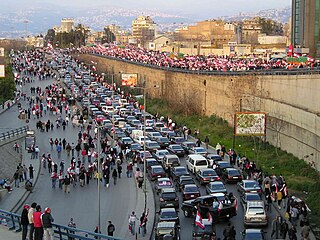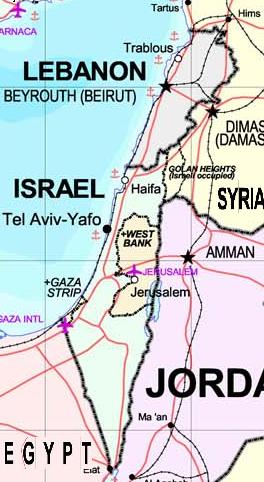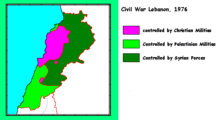
Fatah, formerly the Palestinian National Liberation Movement, is a Palestinian nationalist and social democratic political party. It is the largest faction of the confederated multi-party Palestine Liberation Organization (PLO) and the second-largest party in the Palestinian Legislative Council (PLC). Mahmoud Abbas, the President of the Palestinian Authority, is the chairman of Fatah.

The Palestine Liberation Organization is a Palestinian nationalist coalition that is internationally recognized as the official representative of the Palestinian people. Founded in 1964, it initially sought to establish an Arab state over the entire territory of the former Mandatory Palestine, advocating the elimination of the State of Israel. However, in 1993, the PLO recognized Israeli sovereignty with the Oslo I Accord, and now only seeks Arab statehood in the Palestinian territories that have been militarily occupied by Israel since the 1967 Arab–Israeli War.

The Sabra and Shatila massacre was the 16–18 September 1982 killings of between 460 and 3,500 civilians—mostly Palestinians and Lebanese Shias—in the city of Beirut during the Lebanese Civil War. It was perpetrated by the Lebanese Forces, one of the main Christian militias in Lebanon, and supported by the Israel Defense Forces (IDF) that had surrounded Beirut's Sabra neighbourhood and the adjacent Shatila refugee camp.

The Popular Front for the Liberation of Palestine – General Command or PFLP-GC is a Palestinian nationalist militant organisation based in Syria.

The 1982 Lebanon War began on 6 June 1982, when the Israel Defense Forces (IDF) invaded southern Lebanon. The invasion followed a series of attacks and counter-attacks between the Palestine Liberation Organization (PLO) operating in southern Lebanon and the IDF that had caused civilian casualties on both sides of the border. The military operation was launched after gunmen from the Abu Nidal Organization attempted to assassinate Shlomo Argov, Israel's ambassador to the United Kingdom. Israeli Prime Minister Menachem Begin blamed Abu Nidal's enemy, the PLO, for the incident, and used the incident as a casus belli for the invasion.

The Lebanese Civil War was a multifaceted armed conflict that took place from 1975 to 1990. It resulted in an estimated 150,000 fatalities and also led to the exodus of almost one million people from Lebanon.

George Habash, also known by his laqab "Al-Hakim", was a Palestinian politician and physician who founded the Marxist–Leninist Popular Front for the Liberation of Palestine (PFLP).

As-Sa'iqa officially known as Vanguard for the Popular Liberation War - Lightning Forces, is a Palestinian Ba'athist political and military faction created and controlled by Syria. It is linked to the Palestinian branch of the Syrian-led Ba'ath Party, and is a member of the broader Palestine Liberation Organization (PLO), although it is no longer active in the organization. Its Secretary-General is Dr. Mohammed Qeis.

The 1978 South Lebanon conflict began after Israel invaded southern Lebanon up to the Litani River in March 1978, in response to the Coastal Road massacre near Tel Aviv by Lebanon-based Palestinian militants. The conflict resulted in the deaths of 1,100–2,000 Lebanese and Palestinians, 20 Israelis, and the internal displacement of 100,000 to 250,000 people in Lebanon. The Israel Defense Forces gained a military victory against the Palestine Liberation Organization as the latter was forced to withdraw from southern Lebanon, preventing it from launching attacks on Israel from across its land border with Lebanon. In response to the outbreak of hostilities, the United Nations Security Council adopted Resolution 425 and Resolution 426 on 19 March 1978, which called on Israel to immediately withdraw its troops from Lebanon and established the United Nations Interim Force in Lebanon (UNIFIL).
The War of the Camps, was a subconflict within the 1984–1990 phase of the Lebanese Civil War, in which the Palestinian refugee camps in Beirut were besieged by the Shia Amal militia.

The Damour massacre took place on 20 January 1976, during the 1975–1990 Lebanese Civil War. Damour, a Maronite Christian town on the main highway south of Beirut, was attacked by left-wing militants of the Palestine Liberation Organisation and as-Sa'iqa. Many of its people died in battle or in the massacre that followed, and the others were forced to flee. According to Robert Fisk, the town was the first to be subject to ethnic cleansing in the Lebanese Civil War. The massacre was in retaliation to the Karantina massacre by the Phalangists.

The Palestine Liberation Army is ostensibly the military wing of the Palestine Liberation Organization (PLO), set up at the 1964 Arab League summit held in Alexandria, Egypt, with the mission of fighting Israel. However, it has never been under effective PLO control, but rather it has been controlled by its various host governments, usually Syria. Even though it initially operated in several countries, the present-day PLA is only active in Syria and recruits male Palestinian refugees.
Fatah al-Intifada is a Palestinian militant faction founded by Said Muragha, better known as Abu Musa. Officially it refers to itself as the Palestinian National Liberation Movement - "Fatah", the identical name of the major Fatah movement. Fatah al-Intifada is not part of the Palestine Liberation Organization (PLO).

The siege of Tel al-Zaatar, alternatively known as the massacre of Tel al-Zaatar, was an armed siege of Tel al-Zaatar, a fortified, UNRWA-administered refugee camp housing Palestinian refugees in northeastern Beirut, that ended on August 12, 1976 with the massacre of at least 1,500 people. The siege began in January of 1976 with an attack by Christian Lebanese militias led by the Lebanese Front as part of a wider campaign to expel Palestinians, especially those affiliated with the opposing Palestine Liberation Organization (PLO) from northern Beirut. After five months, the siege turned into a full-scale military assault in June and ended with the massacre in August 1976.

The Syrian occupation of Lebanon began in 1976, during the Syrian intervention in the Lebanese Civil War, and ended on April 30, 2005, after the Cedar Revolution and several demonstrations in which most of the Lebanese people participated. The withdrawal agreement was signed by President Bashar al-Assad and Saad Hariri, son of Rafic Hariri, whose assassination triggered the series of events leading to the withdrawal.

The Israeli–Lebanese conflict, or the South Lebanon conflict, is a series of military clashes involving Israel, Lebanon and Syria, the Palestine Liberation Organization, as well as various militias and Militants acting from within Lebanon. The conflict peaked in the 1980s, during the Lebanese Civil War, and has abated since.

The South Lebanon conflict, designated by Israel as the Security Zone in Lebanon Campaign, was a protracted armed conflict that took place in southern Lebanon from 1985 to 2000. It saw fighting between Israel and the Catholic Christian-dominated South Lebanon Army (SLA) against Hezbollah-led Shia Muslim and left-wing guerillas within the Israeli-occupied "Security Zone"; the SLA had military and logistical support from the Israel Defense Forces over the course of the conflict and operated under the jurisdiction of the Israeli-backed South Lebanon provisional administration, which succeeded the earlier Israeli-backed State of Free Lebanon. It can also refer to the continuation of the earlier conflict in this region involving the growing Palestinian insurgency in South Lebanon against Israel following the expulsion of the Palestine Liberation Organization (PLO) from Jordan after Black September. Historical tensions between Palestinian refugees and Lebanese factions contributed another layer to the Lebanese Civil War (1975–1990), which saw the Maronite-led Lebanese Front and the Shia Amal Movement at war with the PLO. Hence, the South Lebanon conflict can partly be seen as an extension of the civil war that ended in 1990.

The Israeli occupation of Southern Lebanon formally began in 1985 and ended in 2000 as part of the South Lebanon conflict. In 1982, Israel invaded Lebanon in response to a spate of attacks carried out from Lebanese territory by Palestinian militants, triggering the 1982 Lebanon War. The Israel Defense Forces (IDF) and allied Christian Lebanese militias subsequently seized large parts of Lebanon, including the capital city of Beirut, amid the hostilities of the wider Lebanese Civil War. Israel later withdrew from most of the occupied territory between 1983 and 1985, but retained control over areas along the Israel–Lebanon border that would later comprise the Israeli "Security Zone" in coordination with the separatist State of Free Lebanon, which collapsed in 1984. From 1985 onwards, Israel supported the South Lebanon Army (SLA), the Lebanese Christian quasi-military of the collapsed Free Lebanon State, against Hezbollah and other Muslim militants in most of Southern Lebanon; Israel's overall stated purpose for the Security Zone was to create a buffer separating Israeli civilians in northern border towns from Lebanon-based terrorists. In 1993, it was estimated that there were 1,000–2,000 Israeli troops and 2,300 SLA troops active in the area.

During the 1982 Lebanon War, the city of Beirut was besieged by Israel following the breakdown of the ceasefire that had been imposed by the United Nations amidst the Lebanese Civil War. Beginning in mid-June, the two-month-long siege resulted in the expulsion of the Palestinian Liberation Organization (PLO) from Beirut and the rest of Lebanon.
The Battle of Tripoli was a major battle during the middle of the Lebanese Civil War in late 1983. It took place in the northern coastal city of Tripoli between pro-Syrian Palestinian militant factions and the Palestine Liberation Organization (PLO) led by Yassir Arafat. It resulted in the withdrawal of PLO and mostly ended their involvement in the war.


















